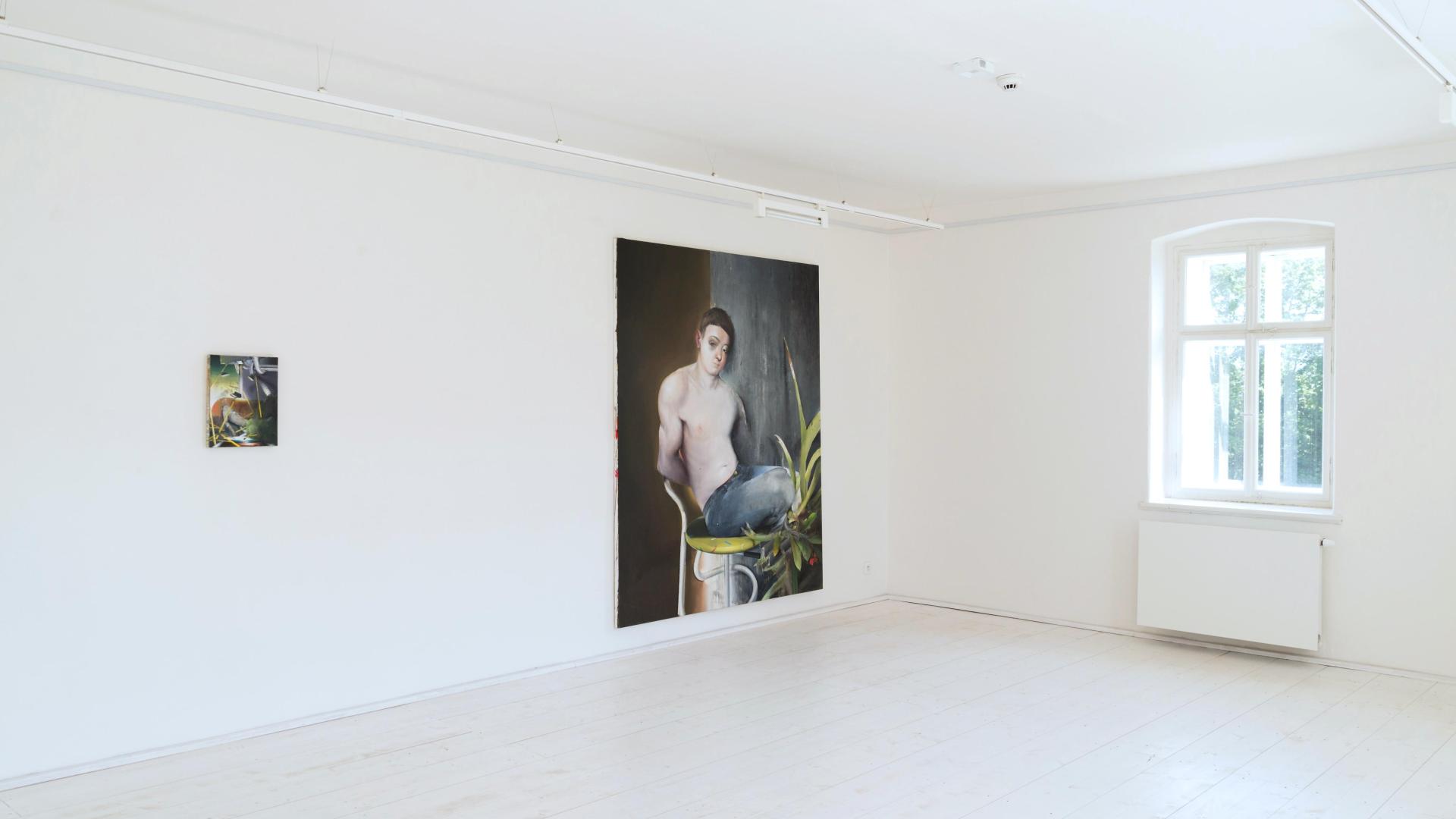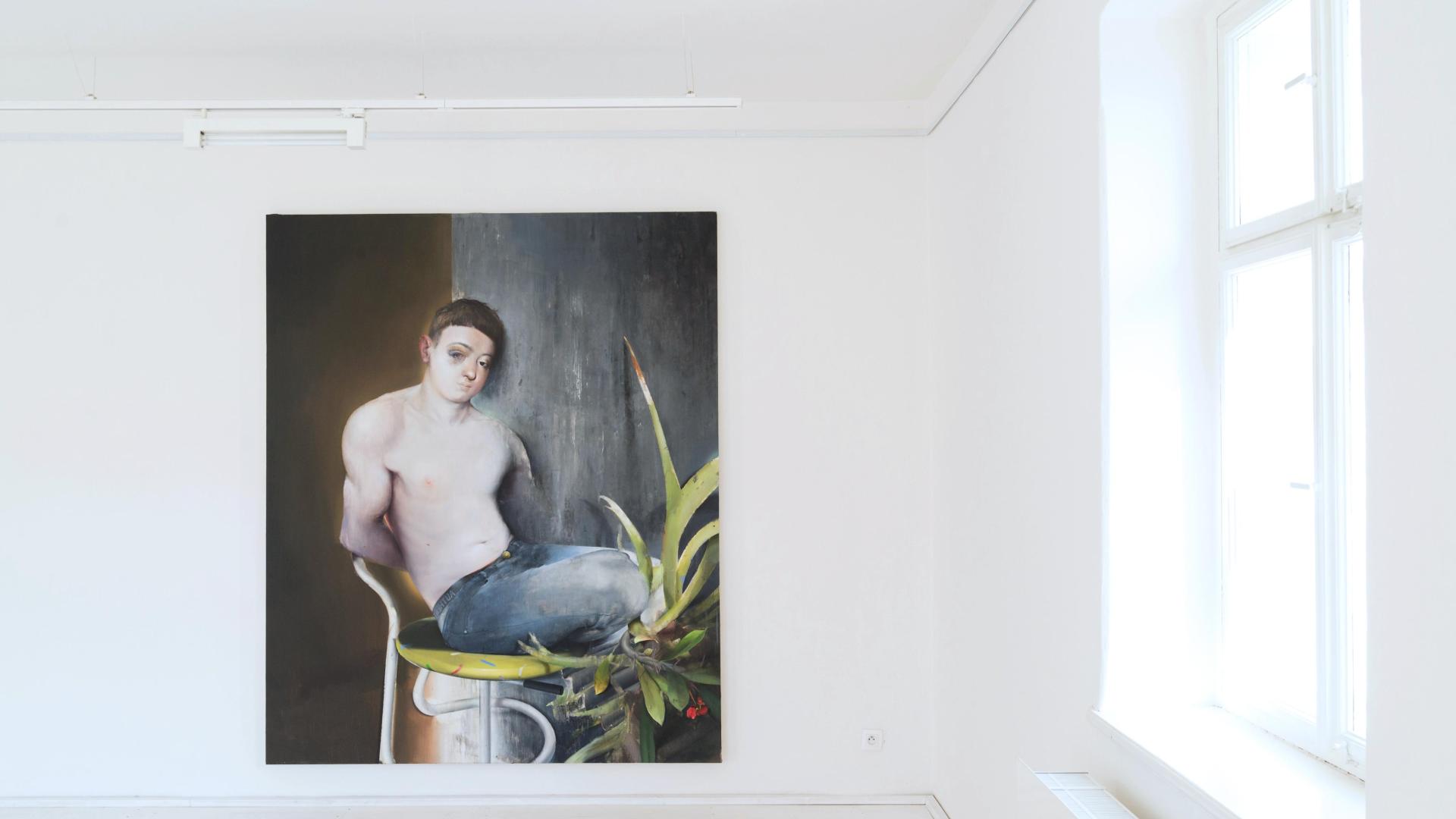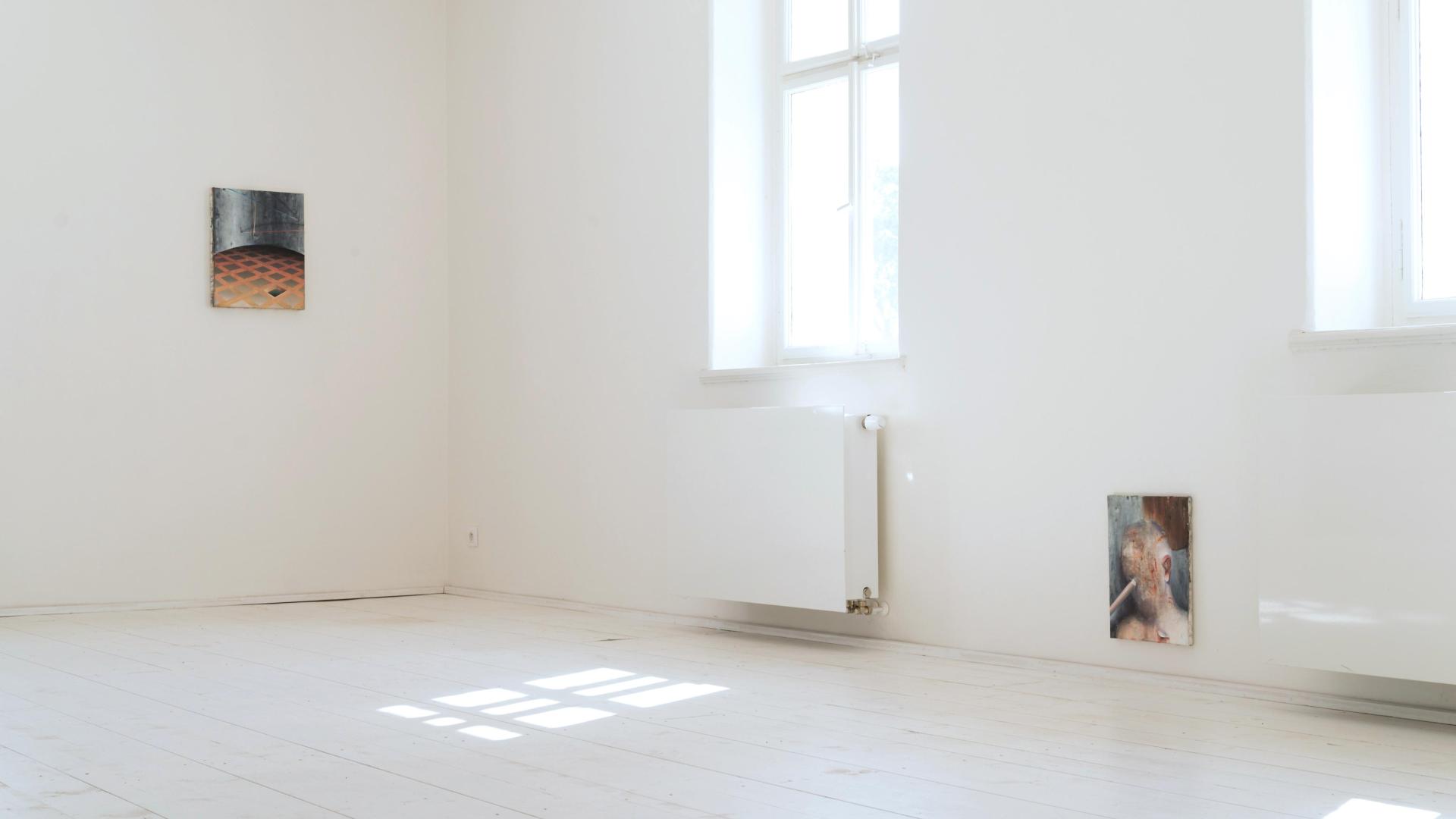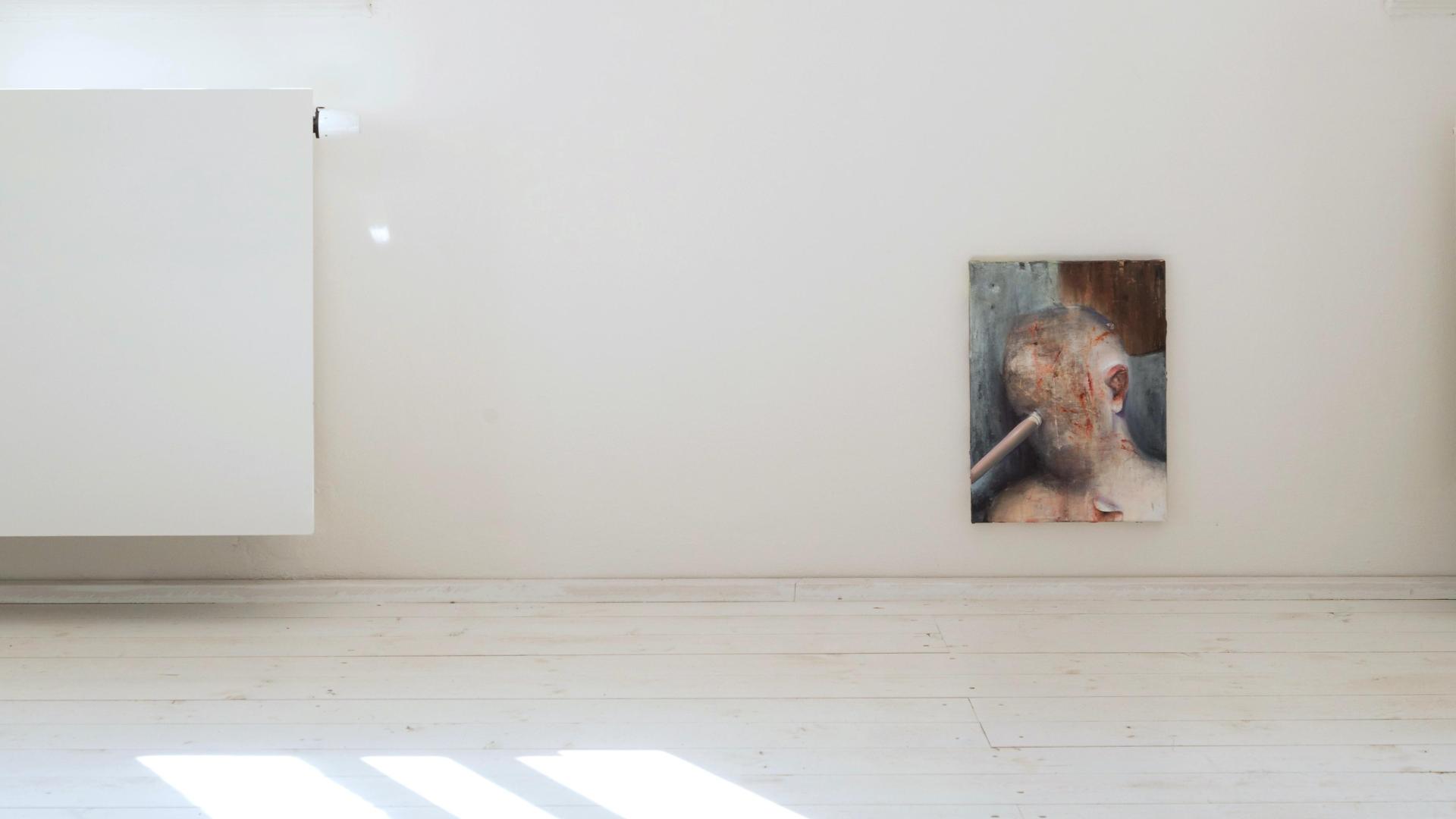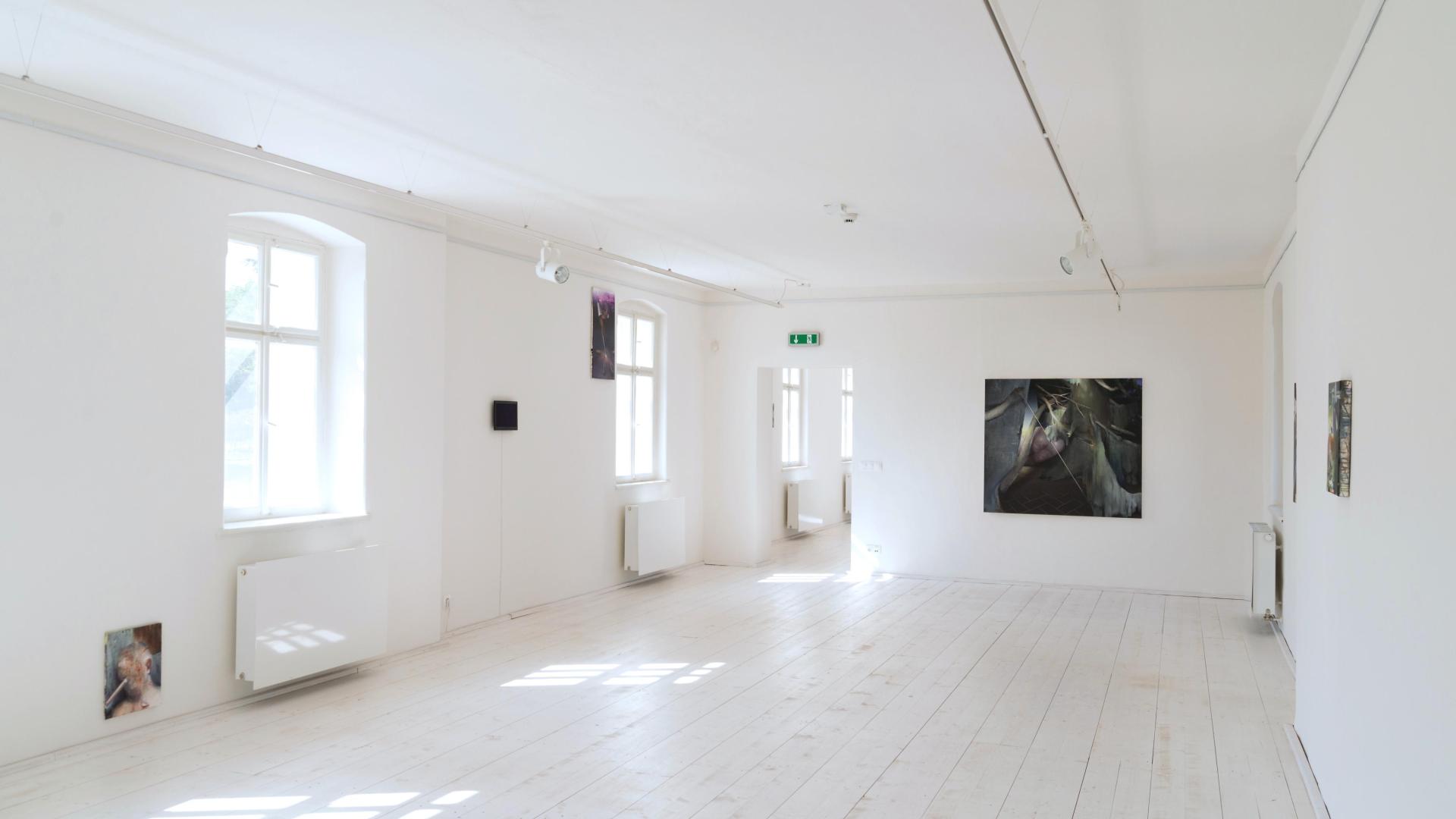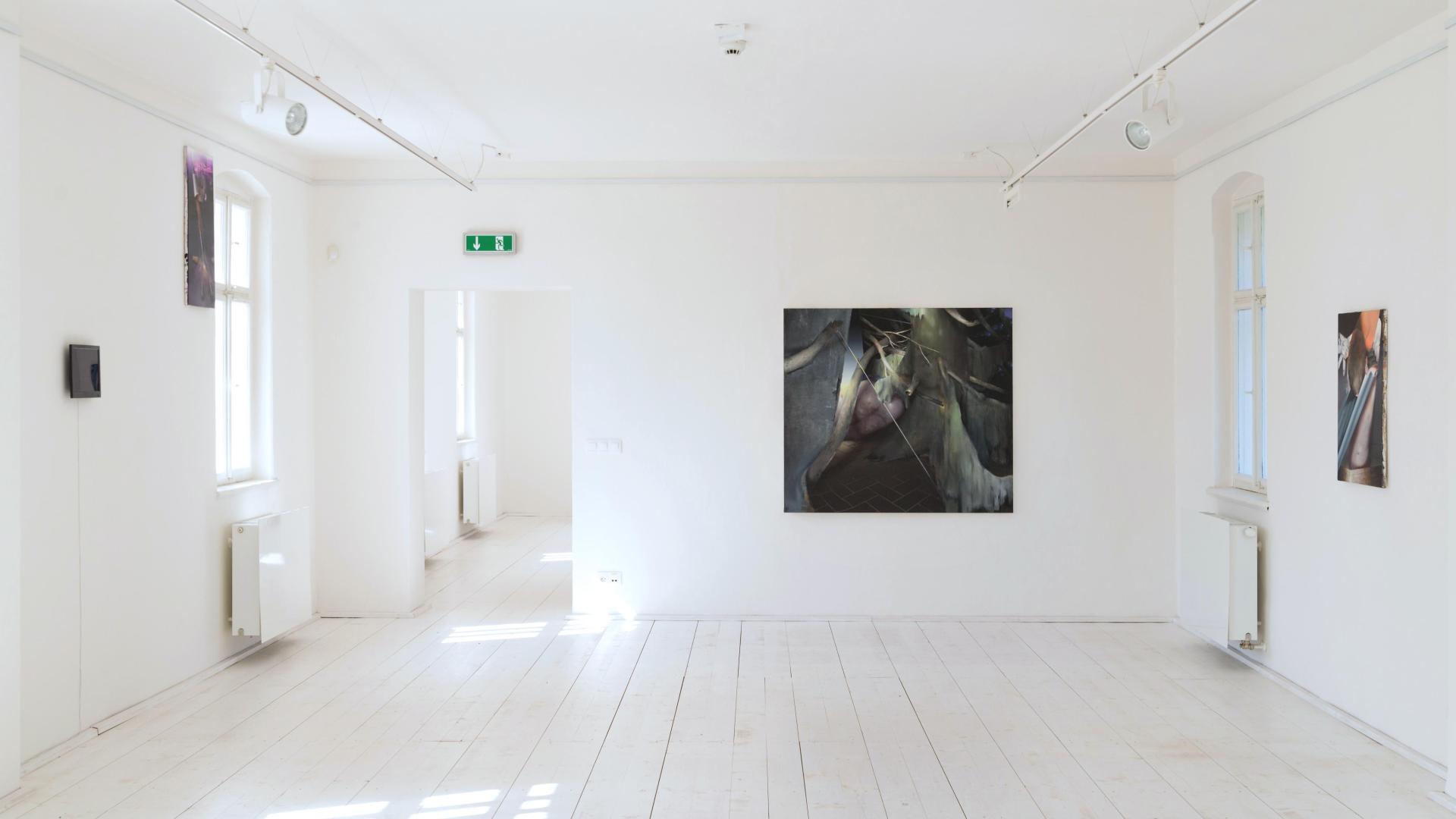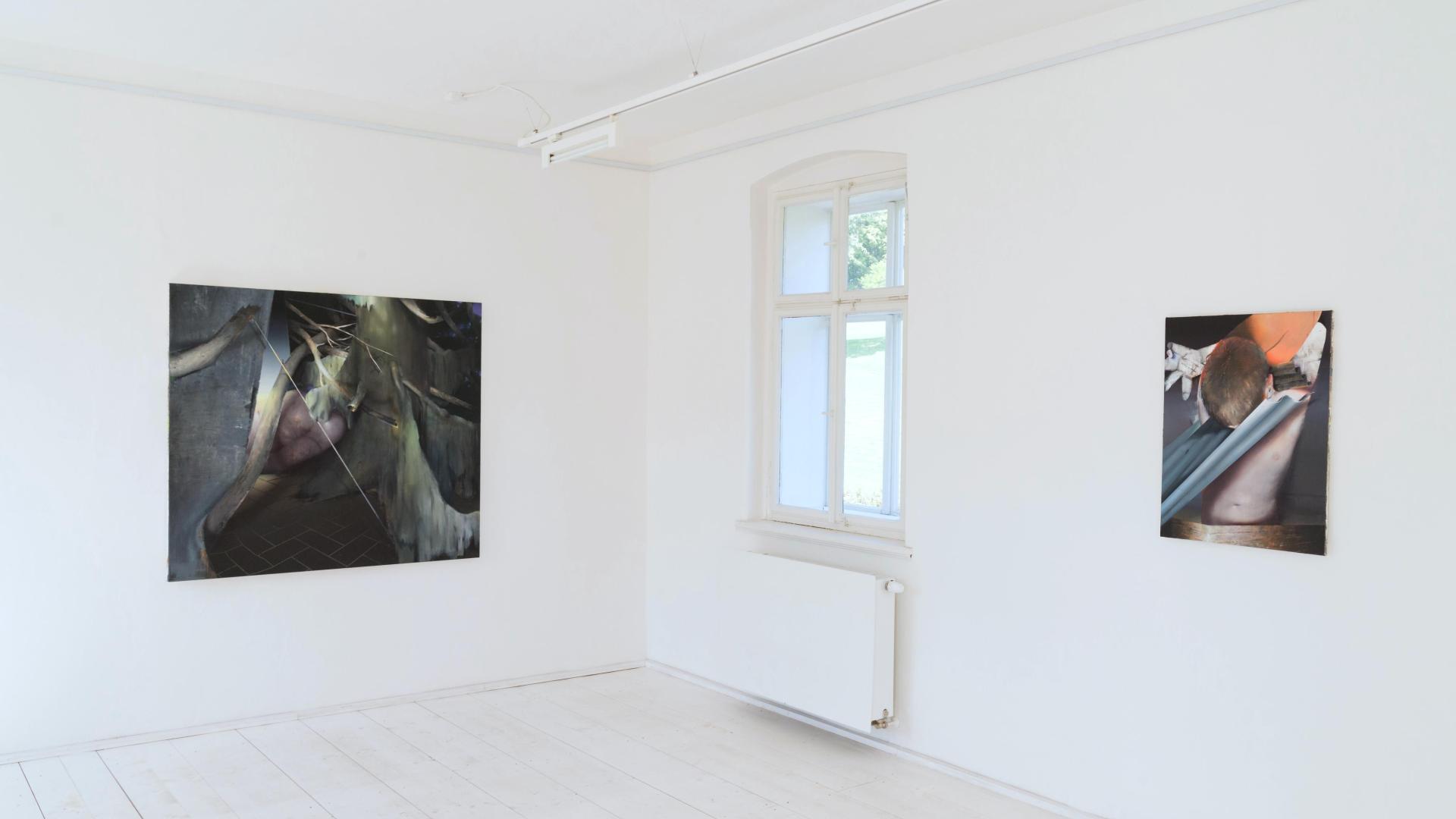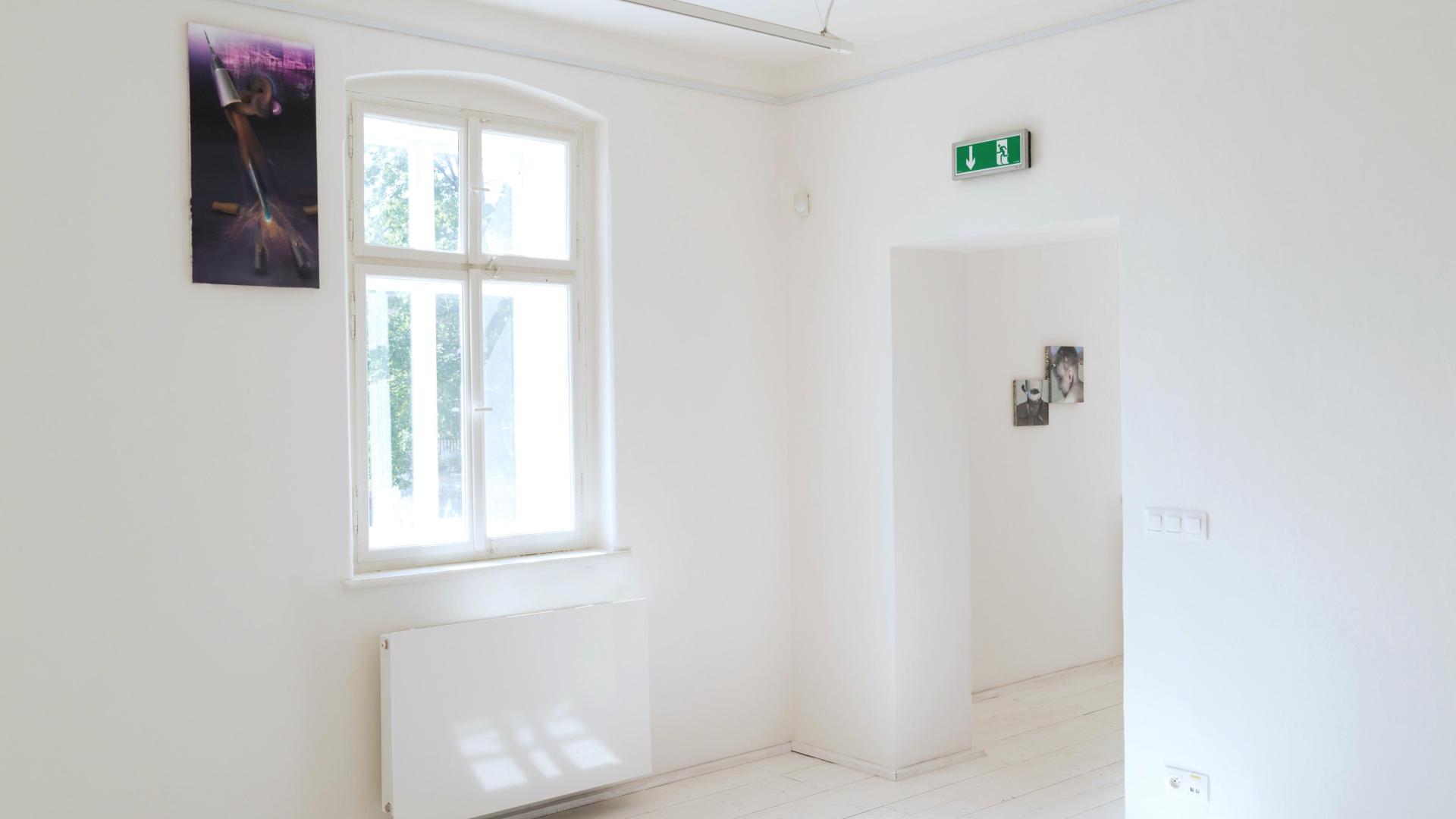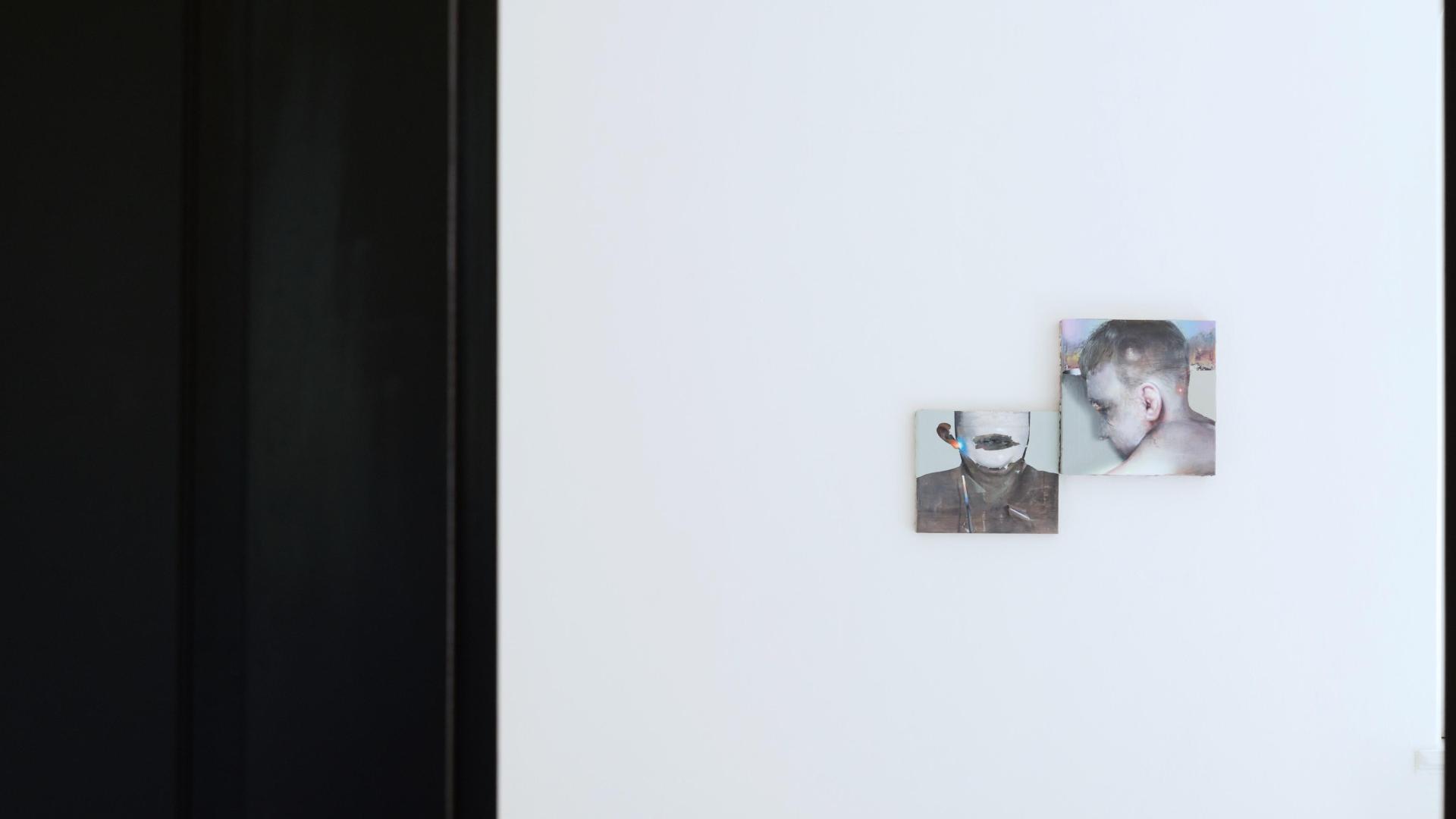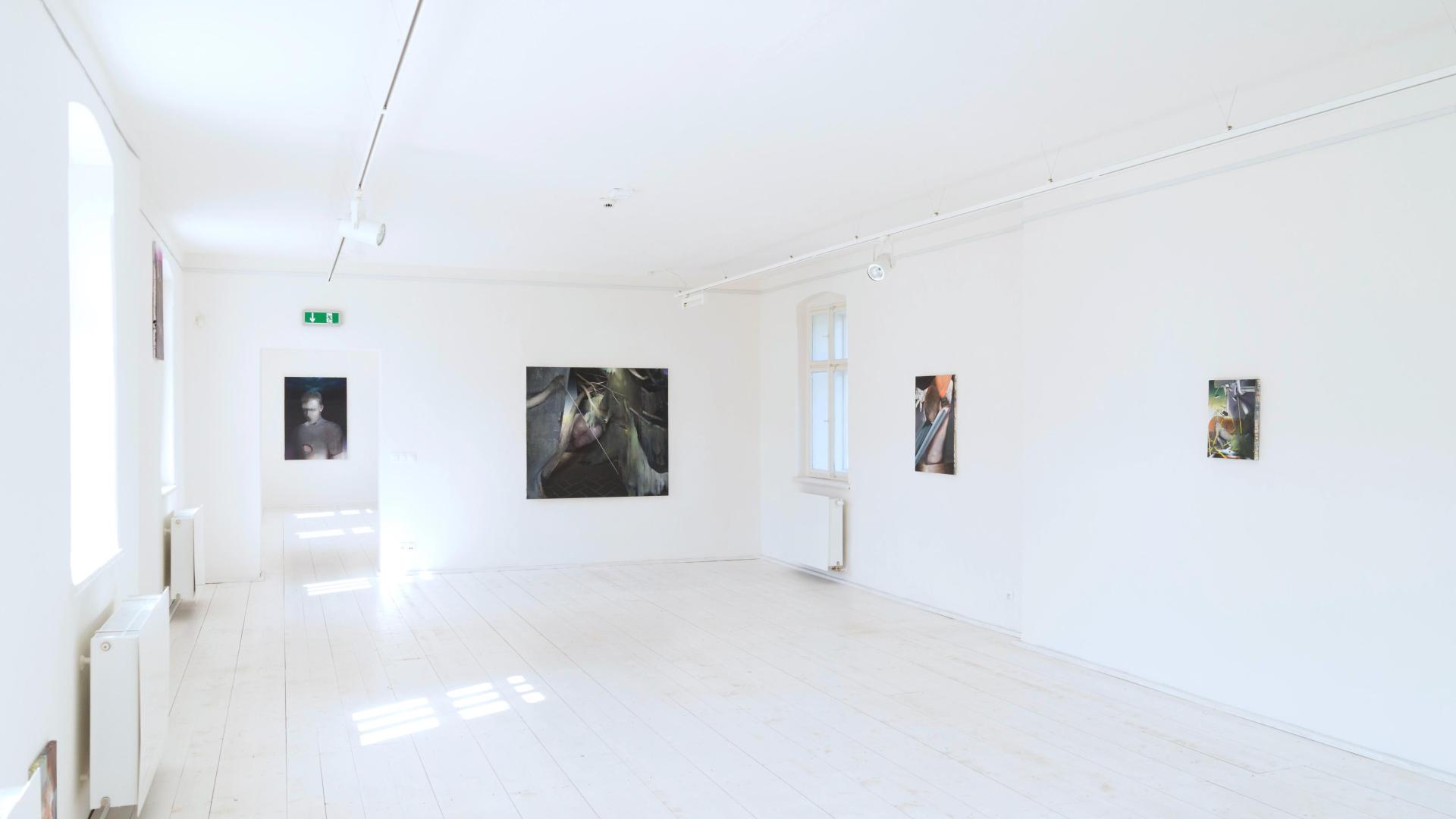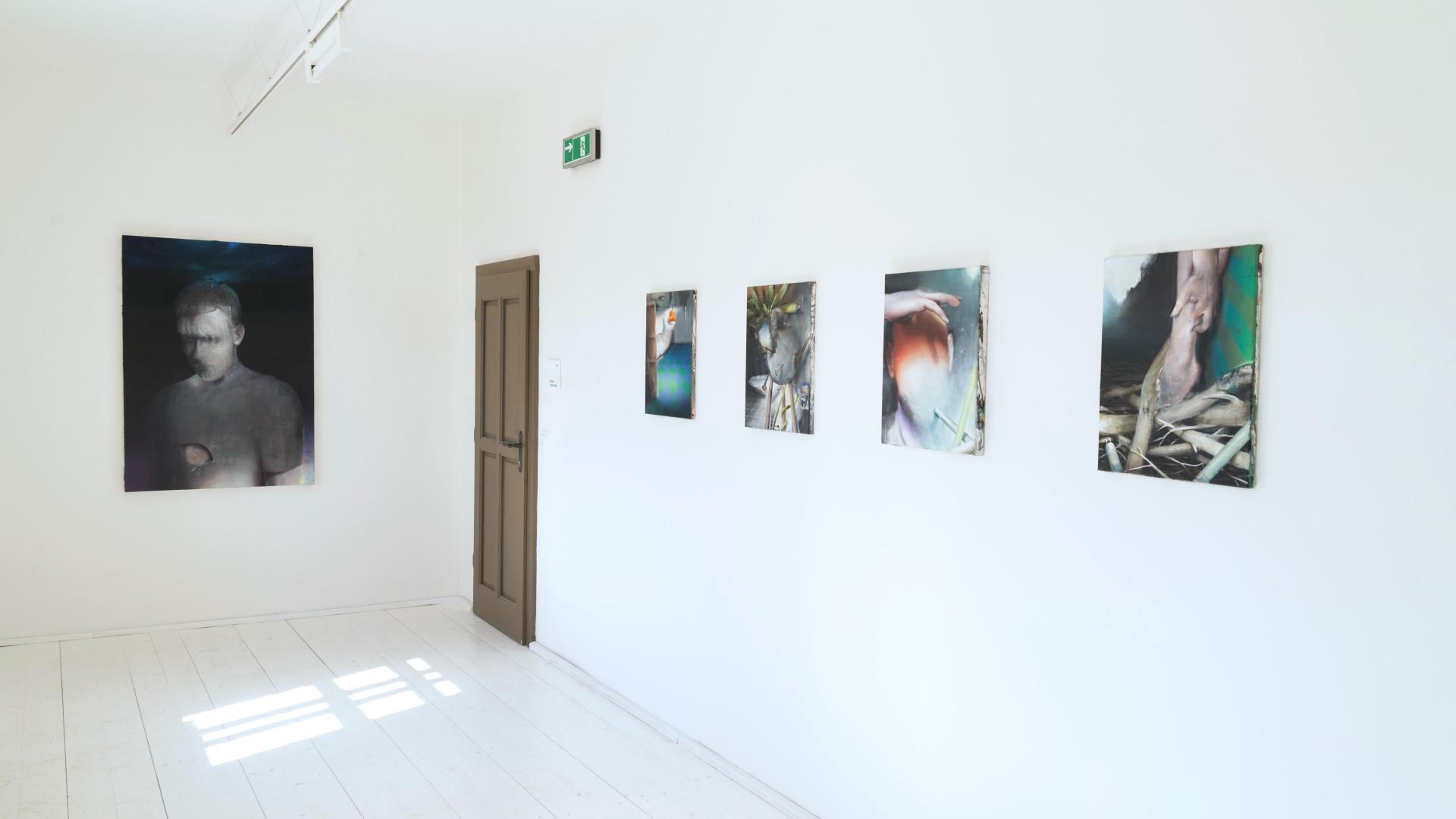
Master of None
—
Galerie Dům, Broumov, CZ
Solo exhibition
Curator: Petr Vaňous
Jiří Marek ranks among the most promising artists of the younger generation born in the early 1990s. The poetics of his painting are introspective, subliminally profound and melancholic. He presents an expanded landscape of interpersonal relations as a form of “hallucination”, as a “fragmented world” that must be patiently reassembled, defragmented, revived and purified. He takes a similar approach to the cultural legacy of the past, which must be reshaped into a new sense of the present. Everything seems to be in slow motion; this is the only way in which we can observe and grasp the artist’s ongoing inner transformation, which he works with and imbues with strikingly pictorial features. His focus on “breaking through the temporal planes of experience” also contains within itself the purifying catharsis of spiritual exercises. These are exercises in the form of painting, whose task is to clarify and purify our connection with history and the past as living prefigurations of the present. Something ostensibly archaic is radicalized, undermining the certainty of what is “developmentally transcended” and making human destiny present again in its recurring nakedness, vulnerability and Heideggerian thrownness.
If we look back, we see that Jiří Marek’s paintings have long been rooted in the transformation of a purely pictorial, essential and visual poetics into a compulsion to take up and express a personal and generational stance towards a world which puts up experiential resistance, becomes alienated and appears non-identical. This corresponds with a transformation of the paintings’ expressive resources, a shift from the sensory reflection of unifying phenomenal surfaces and towards a command of expressive resources that function as a parallel communicative language – though the (self-)criticality of this language causes it to disintegrate into mutually isolated and solitary “utterance fragments” which often confront each other in polarizing contrasts. This has led to an increasingly prominent sense of drawn-ness in Marek’s forms, a pronounced descriptiveness, materiality and focus on detail – yet there is also a scepticism towards the whole, which in relation to the current sensibility is constantly in flux, oscillating and evasive. Whereas the past appears to be systematically structured and transparent, the construction of a unified present proves problematic.
Marek uses associational metaphor as a tool to address the impossibility of attaining distance from the present day – to which he is nevertheless directly connected. In order for this “conceptualization” of an image to be effective, the image itself must be transformed in its very essence from the outset. If we consider this, we realize that Jiří Marek builds images as a form of reviving “ruin”, which adopts and integrates into itself (though not systematically!) various layers of consciousness and experiences from various times. The paintings incorporate historical stylistic frameworks, citations of iconographic attributes and figures (or mere imprints, traces and fragments of them), as well as references to various works by specific artists (e.g. Caravaggio’s Sick Bacchus). These function as a pre-prepared “hosting” platform, a familiar and guiding substrate into which the artist can insert any radical gesture freed from the constraints of time – and such a gesture may be concealed even in a mere detail. This creates relational fields whose level of dramatization and intensity corresponds with the degree of critical dislocation expressed in the work. By doing so, Marek is able to reflect the contradictions that he sees as fundamentally inherent in the present day.[1]
The prospect of breaking through into one’s own time leads via the destruction of temporal-spatial unity and the heterogeneity of the narratives that are used. Everything seems to be in constant contradiction with everything else. Each thing, each figure, each environment makes it impossible for us to identify with the motion of our own experience (Caryatid, 2021).
Instead, everything here is in counter-motion, everything is turned inside out, governed by a kind of inverse dynamics – or rather inverse “mechanics” (Target, 2022). It is as if everything (metaphorically) obstructs everything else, casting shade on it and standing (insidiously) in the way of something that we could describe as a state of liberation and enlightenment (Return, 2022). The past, with its potentiality for identification, is dismantled and reworked into new models of doubt and uncertainty (Trinitá, 2022). There are no authoritative iconographic and iconological formulas here, and even the unity of spatial structure is disintegrated (Pincushion, 2021). Deformed narratives clash with each other, ruthlessly cutting their way through the matrix or inserting themselves into obscured between-spaces which they attempt to fill and control (Concrete Tent, 2022). The idea of an entire entity is declared to be an enveloped or enmeshed “competitive motion” of forms, which subjugates everything to its own purpose and thus devalues everything that defies utility, exchange and representation. The painting also refers to the notion of fetish – the objectification of art by contemporary artistic practices that generate and intensify external pressures on an artist’s “objective” performance.
The themes that Jiří Marek’s art addresses are permeated with critical reflections of the “commodity structures” (Theodor W. Adorno)[2] on which contemporary society is founded. Free art is increasingly perceived as a commodity for exchange and “investment” – weakening or even eliminating the liberating and regenerative motion within the creative principle itself, which is surrounded and deformed from all sides by representation and objectification. The role of an artist who comes under pressure to “produce” is shifting – and this is one of the reasons behind the pervasive melancholy in Marek’s work: “Pressures to produce, the impossibility of resting, of being empty and without ideas, the (as I see it) senseless manufacturization of something intrinsic, something which needs time and needs a reason – not only in terms of content, but also in terms of form (hence the head pierced by a brush, an interpretation of Velázquez’s Las Meninas, when all that remains of the artist is a collapsed torso that is inappropriately large within the space, or the painting Blank, in which the face is so over-lit that it is lost and becomes empty).”[3]
The title of this Broumov exhibition, Master of None, is paradoxical only at first glance. The “master of none” may appear to be a personification of the fragmentary ambivalence that can be read in semantic opposites. It is either somebody who pragmatically goes with the flow and gains speed, which gives way to impersonality and a void of values, or on the other hand it is somebody who has travelled in the opposite direction – against the flow, preserving their own identity despite unfavourable circumstances and challenging conditions amid the expanding ocean of the non-identical world, somebody who has found their own distinctive constellations and who repeatedly makes present the singular phenomena of the present day. This second path is the one that Jiří Marek has taken; he prefers pure (yet not painless) experience over the facile “production of art” which never lacks for demand or for the constant applause of its admirers. This is why Marek continues to explore situations that disrupt (purposely interrupt!) representation (or the representative unity of the work) in order to support the critical momentum of ongoing conflict which opens up a subversive space for painting, a space that is present behind the outward aesthetics of its forms.[4] Jiří Marek’s paintings compress and make a collage of individual experience, which inserts itself into a stabilizing and unifying layer of generational feeling shared by artists from the youngest generation, opening up a new perspective on the ostensibly unchanging state of things.
1. The painting The Inhibitionist (2022).
2. Susan Buck-Morss, The Origin of Negative Dialectics. Theodor W. Adorno, Walter Benjamin and the Frankfurt Institute. Cited from the Czech translation Původ negativní dialektiky. Theodor W. Adorno, Walter Benjamin a frankfurtský Institut pro sociální výzkum, Praha 2020, translated by Martin Ritter, p. 71.
3. From Jiří Marek’s own notes.
4. Hence the eloquent titles of paintings such as Discord (2022), Concrete Tent (2022), Blank (2022), Screw That Shit Already (2022), The Devil’s in the Details (2022), Trinitá (2022), etc.
Jiří Marek patří mezi slibné autory nastupující malířské generace narozené na počátku 90. let. Jeho malířská poetika je introspektivní, podprahově hlubinná a melancholická. Předkládá rozšířený půdorys mezilidských vztahů jako svého druhu „halucinaci“, jako „roztříštěný svět“, který je nutné znovu trpělivě skládat, defragmentovat, znovu oživovat a pročišťovat. Podobně vnímá kulturní odkaz minulosti, který je nutno přetvořit do nového pocitu současnosti. Vše jako by spočívalo ve zpomaleném pohybu, který jedině umožňuje pozorovat a zachytit probíhající autorovu vnitřní transformaci, s níž pracuje a které propůjčuje výrazné malířské rysy. Koncentrace na „prolamování časových rovin zkušenosti“ v sobě obsahuje také očistnou katarzi duchovních cvičení. Jsou to malířské exercicie, které mají za úkol vyjasnit a očistit vztah k dějinám a minulosti jako k živým předobrazům dneška. Cosi zdánlivě archaického se tu radikalizuje, aby byla podlomena jistota z tzv. vývojově překonaného, a aby tu byl opět zpřítomněn lidský osud v jeho opakující se nahotě, zranitelnosti a heideggerovské vrženosti.
Podíváme-li se zpět, pak malířská tvorba Jiřího Marka dlouhodobě vychází z transformace čistě malířské, esenciální a vizuální poetiky v nutnost zaujmout a vyjádřit osobní a generační stanovisko vůči světu, který klade zkušenostní odpor, odcizuje se a jeví se jako ne-identický. Tomu odpovídá proměna výrazových prostředků malby směrem od smyslové reflexe sjednocujících fenomenálních povrchů k ovládnutí výrazu jako paralelního sdělovacího jazyka, jež se však díky své (sebe)kritičnosti rozpadá na vzájemně osamělé a osamocené „výrokové fragmenty“ stavící se často do polarizačních protikladů. Odtud stále výraznější smysl pro kresebnost forem, popisnost, materializaci, detail, ale i přítomnost skepse vůči celku, který ve vztahu k současnému pocitu neustále těká, osciluje a uniká. Zatímco minulost se zdá být systematicky strukturovaná a přehledná, s konstruováním sjednocené přítomnosti nastává problém.
Nemožnost odstupu od současnosti, ke které se ale autor bezprostředně vztahuje, řeší prostřednictvím nástroje asociační metafory. Aby tato „konceptualizace“ obrazu vyzněla, musí být od počátku proměněn samotný obraz ve svém založení. Zaměříme-li se na tuto skutečnost, uvědomíme si, že Jiří Marek buduje obraz jako svého druhu ožívající „ruinu“, která přijímá a do sebe integruje (nikoliv ovšem systematicky!) různé vrstvy vědomí a zkušenosti z různých časů. Do malby vstupují historické stylizační rámce, citace ikonografických atributů a postav (nebo jen jejich otisky, stopy, fragmenty), stejně jako odkazy na známá díla konkrétních umělců (např. Nemocný Bakchus od Caravaggia)1. Fungují jako předpřipravená „hostící“ platforma, jako povědomý a orientující substrát, do něhož lze zasadit jakkoliv radikální gesto vyvázané z totality času, přičemž toto gesto může být ukryto i v pouhém detailu. Vznikají tak vztahová pole, jejichž míra dramatizace a vyhrocení odpovídá stupni kritického vybytí. Důvodem tohoto počínání je reflexe „rozpornosti“, kterou autor prožívá jako základní vlastnost současnosti.[1]
Možnost, jak se prolomit do svého vlastního času, vede přes destrukci časoprostorové jednoty a přes heterogenitu použitých narativů. Vše si tu jakoby neustále odporuje. Každá věc, každá figura, každé prostředí tu brání tomu, identifikovat se s pohybem vlastní zkušenosti (Karyatida, 2021).
Naopak se zde vše dostává do protipohybů, vše se převrací naruby ovládáno jakousi inverzivní dynamikou či spíše „mechanikou“ (Terč, 2022). Jako by si vše vzájemně (metaforicky) překáželo, stínilo a stálo si (zákeřně) v cestě za něčím, co bychom mohli označit jako stav osvobození a prozření (Return, 2022). Minulost je ve své identifikační potencionalitě demontována a přepracována v nové modely znejistění (Trinitá, 2022). Neplatí tu žádné závazné ikonografické a ikonologické vzorce, rozkládána je i jednota prostorové výstavby (Pincushion, 2021). Deformované narativy do sebe vzájemně narážejí, bezohledně si klestí cestu matrixem, nebo se zasouvají do ztemnělých meziprostorů, které se snaží vyplnit a ovládnout (Concrete Tent, 2022). Idea celku je tu deklarována jako zapouzdřený či zacyklený „konkurenční pohyb“ forem, který vše podřizuje svému účelu a devalvuje tak cokoliv, co se vymyká užitnosti, směně a reprezentaci. Obraz mimo jiné odkazuje také na memento fetiše, tj. zvěcňování umění současným uměleckým provozem, který generuje a stupňuje vnější tlak na „objektivní“ výkon umělce.
Obrazovými náměty, jak je volí Jiří Marek, prostupuje kritická reflexe „komoditní struktury“ (Theodor W. Adorno)[2], na níž spočívá současná společnost. Volné umění je čím dál tím více pociťováno jako směnné zboží a „investice“, čímž je oslabován, či dokonce eliminován osvobozující a obrodný pohyb uvnitř samotného tvůrčího principu, který je obkličován a ze všech stran deformován reprezentací a zvěcněním. Role umělce, který se dostává pod „výrobní“ tlak, se proměňuje a je jednou z příčin všudypřítomné melancholie. Jak pojmenovává své současné pocity Jiří Marek ve vazbě na svá konkrétní díla: „Tlaky na produkci, nemožnost si odpočinout, být prázdný a bez nápadu, pro mě nesmyslná manufakturizace něčeho niterného, co potřebuje svůj čas a důvod - nejenom obsahový, ale i formální (proto hlava propíchnutá štětcem, Interpretace Velázquezových Las Meninas, kdy z umělce zbylo jen zborcené torzo nepatřičně velké v prostoru, nebo obraz Blank, kdy je obličej tak přesvícen, že se ztrácí a je prázdný).“[3]
Název broumovské výstavy Master of None je pouze zdánlivě paradoxním výrokem. „Mistr ničeho“ se může jevit jako zosobnění tříštivé ambivalence, kterou lze číst ve významových opozitech. Je to buď někdo, kdo se pragmaticky veze s proudem a nabírá na rychlosti, jež ústí do neosobnosti a hodnotového prázdna, nebo naopak někdo, kdo se vydal opačným směrem – proti proudu, aby si navzdory nepříznivým okolnostem a ztíženým podmínkám uchoval svou vlastní identitu uprostřed rozšiřujícího se oceánu ne-identického světa a prostřednictvím svébytně nalézaných konstelací opakovaně kriticky zpřítomňoval partikulární fenomény dneška. Druhá z nabízených možností je i volbou Jiřího Marka, který dává přednost ryzí, byť ne bezbolestné zkušenosti, před snadnou „produkcí umění“, po níž neustává poptávka a nepolevuje konstantní potlesk obdivovatelů. Proto se autor ve své malbě vrací k situacím, jež narušují (cíleně přerušují!) reprezentaci, respektive reprezentační jednotu díla, aby podpořil kritický moment rozehraného konfliktu, jenž pro malbu otevírá subversivní prostor přítomný za vnější estetikou forem.[4] Obrazy Jiřího Marka komprimují a kolážují individuální zkušenost, která se vřazuje do ustalující se a jednotící vrstvy generačního pocitu umělců nejmladší generace otevírající nový pohled na zdánlivě neměnný stav věcí.
1. Obraz Inhibicionista (2022)
2. Susan Buck-Morssová, Původ negativní dialektiky. Theodor W. Adorno, Walter Benjamin a frankfurtský Institut pro sociální výzkum, Praha 2020, překlad Martin Ritter, s. 71.
3. Z autorských poznámek J. Marka.
4. Odtud také výmluvné názvy obrazů, např. Svár (2022), Concrete Tent (2022), Blank (2022), Screw That Shit Already (2022), The Devil’s in the Details (2022), Trinitá (2022) ad.
